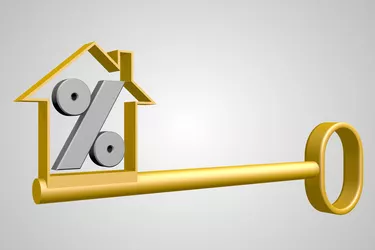
The loan-to-value ratio compares the amount of a new loan request or an existing mortgage balance to the purchase price or appraised value of a home. Whether you're dealing with a new mortgage or a home refinance situation, a low LTV ratio is better for both you and your lender. However, in some situations, what's considered "good" may be significantly different from what's considered acceptable.
Understanding LTV
Video of the Day
The formula for calculating LTV differs according to whether you're dealing with a new mortgage or a home refinance.
Video of the Day
- For a new mortgage, divide the amount of the loan request after
subtracting out the down payment by the lower of the purchase price or appraised
value of the home. For example, if the loan request is $200,000 and the home
has an appraised value of $250,000, the LTV is $200,000/$250,000 or 80 percent.
- For a refinance, divide the outstanding loan balance by the
value of your home. For example, if you currently owe $75,000 on a home valued
at $200,000, the LTV ratio is $75,000/$200,000 or 37.5 percent.
Tip
A number of personal finance and home loan websites have free LTV calculators.
LTV vs. Equity
It sometimes can be easier to understand why a low LTV is always better by including a term known as "equity" in the conversation. LTV and equity are the exact opposites of each other. Equity refers to the percentage of your home that you actually own. For example, if your LTV is 80 percent, you actually 20 percent of the home. In contrast, if LTV is 37.5 percent, you own 62.5 percent of your home.
A lender generally will consider a new or refinance loan application with a low LTV as less risky because you have more equity in your home and therefore are less likely to default on the loan. Combined with other factors, such as your income, monthly expenses and credit score, a low LTV often contributes to a lower interest rate.
LTV and Purchase Loans
With a conventional purchase loan, an LTV of at least 80 percent meets the "good" standard. This is the benchmark because a lender won't require you to purchase private mortgage insurance with an LTV of 80 percent or less.
With a Federal Housing Authority loan, an LTV of up to 96.5 percent meets the "good" standard. FHA loans do not come with a PMI requirement, regardless of the LTV.
With some loan guarantee programs, including USDA rural home loans and Department of Veteran's Affairs loans, an LTV of up to 100 percent meets the "good" standard because these loan guarantee programs don't require a down payment. Just like with an FHA loan, they also do not require private mortgage insurance.
LTV and Refinance Loans
Unless you're applying for a cash-out refinance, there may not be such a thing as a "good" or "bad" LTV here. Although the federal Home Affordable Refinance Program requires an LTV of at least 80 percent, many other refinance loans don't include LTV as an eligibility factor. This is especially helpful if you have little equity in your home or are "upside" down, meaning the current balance of your existing mortgage is higher than the value of your home.
For a cash-out refinance, a good LTV can be as high as 90 percent, depending on the loan.